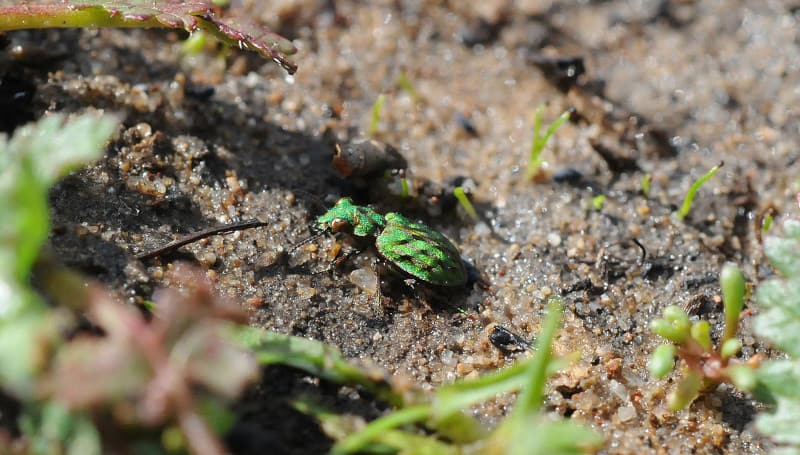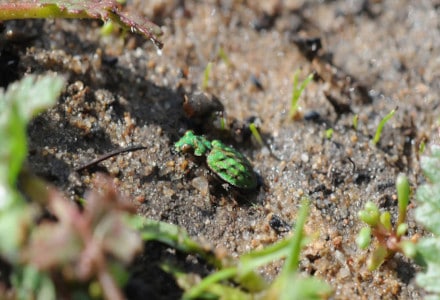
Delta Green Ground Beetle Facts
- This dazzling invertebrate most frequently goes by the descriptive common name of the Delta Green Ground Beetle. Unlike most of its kindred, however, it possesses no alternate general name. That’s largely due to limited human awareness of its presence.
- Among professionals, however, it’s usually referred to by its formal name. That term, though, as many researchers can attest, is somewhat difficult to pronounce. That’s because it bears the moderately cumbersome, as such things go, name Elaphrus viridus.
- It received its official moniker due to the efforts of the respected American entomologist, George Henry Horn. He accomplished the first formal recognition of it as a separate and distinct species. This scientifically noteworthy event occurred in 1878.
- Unfortunately, this marvelous product of Nature and evolution faces numerous factors limiting its chances of survival. This sad fact also holds true throughout the entirety of its range. In fact, the nature of its range itself qualifies as one of those factors.
- Precise estimates of the population of the insect do not currently exist. Nevertheless, given the other problems it faces, the IUCN currently lists it as Critically Endangered. That status appears on the organization’s published Red List of Threatened Species.
- One of the greatest perils the Delta Green Ground Beetle faces stems from the nature of its habitat. Many of the remaining locations of this specific type of ecosystem face possible destruction due to human expansion. It’s also endangered by climate change.
Related Articles
Delta Green Ground Beetle Physical Description
The Delta Green Ground Beetle fasciantes those who know of it. This holds true due to various reasons, of course. One of these, though, pertains to its physical appearance. More specifically, the few studies conducted differ concerning the presence of sexual dimorphism.
Even if present, however, some researchers believe this physiological characteristic manifests itself in terms other than size. Observations remain few, but those indicate that, if indeed exiting, this trait develops in terms of color patterns. That, however, isn’t uncommon.
Mature adults do seem to attain the same approximate physical size, though. All observed mature specimens measured roughly 0.25 in (0.6 cm) in length. It’s therefore immediately obvious that this marvel of Nature enthralls the observor for reasons other than sheer size.
The name of the Delta Green Ground Beetle clearly derives partly from its coloring. This primarily consists of a background of bright metallic-green. Yet, small bronze-colored spots also appear. These markings further vary in size and patterns between individuals.
The other inspiration for its general name also comes from a characteristic of its physiology. This too is a matter of appearance. That’s true because of a small marking appearing on the foremost of its body segments. Many believe this to resemble the Greek letter Delta.
- Kingdom: Animalia
- Phylum: Arthropoda
- Class: Insecta
- Order: Coleoptera
- Family: Carabidae
- Genus: Elaphrus
- Species: E. viridis
Delta Green Ground Beetle Distribution, Habitat, and Ecology
The Delta Green Ground Beetle evolved as native to a region of the world well known for its abundant natural beauty. That’s due to the fact that its evolution occurred within the boundaries of what now represents North America. Its range remained limited, however.
More precisely, the Arthropod only lives in a tiny portion of what’s now the United States. Even there, though, it only lives in an overall area comprising no more than 7,000 acres (2,800 hectares). Its entire known territorial range lies inside of Solano County, California.
Evidence further indicates that it never existed beyond the boundaries of what’s now the Central Valley. Presently, it’s only known to be present in 5 small concentrations. In each case, however, the species demonstrates decided preferences for its choice of habitat.
It seems to prefer riparian ecosystems. These typically consist of such locations as on or near the banks of a river or stream, for one. This also includes regions of wetlands. It also appears along the edges of small, temporary pools of water, generally known as vernal pools.
In both its larval and adult forms, the Delta Green Ground Beetle feeds as a carnivore. It further tends to hunt as an active predator, rather than as an ambush predator. Evidence indicates that it hunts small, soft-bodied arthropods. That mainly consists of springtails.
For the moment, scientists remain uncertain of its own predators. It’s believed to emit a noxious substance from glands, making it unpalatable to most species otherwise prone to hunting it. Observors believe the most likely creature to eat it is a locally abundant tree frog.
Species Sharing Its Range
Check out our other articles on 6 Lovely Lesser-Known Legumes, Snowshoe Hare, Kings Canyon, Swamp Dacrydium, Staghorn Coral, Giant Golden Orb Weaver, Aldabra Giant Tortoise

